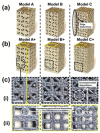Additive Manufacture of Small-Scale Metamaterial Structures for Acoustic and Ultrasonic Applications
- PMID: 34072508
- PMCID: PMC8226526
- DOI: 10.3390/mi12060634
Additive Manufacture of Small-Scale Metamaterial Structures for Acoustic and Ultrasonic Applications
Abstract
Acoustic metamaterials are large-scale materials with small-scale structures. These structures allow for unusual interaction with propagating sound and endow the large-scale material with exceptional acoustic properties not found in normal materials. However, their multi-scale nature means that the manufacture of these materials is not trivial, often requiring micron-scale resolution over centimetre length scales. In this review, we bring together a variety of acoustic metamaterial designs and separately discuss ways to create them using the latest trends in additive manufacturing. We highlight the advantages and disadvantages of different techniques that act as barriers towards the development of realisable acoustic metamaterials for practical audio and ultrasonic applications and speculate on potential future developments.
Keywords: acoustic metamaterials; acoustics; additive manufacturing; ultrasonics.
Conflict of interest statement
The authors declare no conflict of interest.
Figures












































Similar articles
-
Moth wings are acoustic metamaterials.Proc Natl Acad Sci U S A. 2020 Dec 8;117(49):31134-31141. doi: 10.1073/pnas.2014531117. Epub 2020 Nov 23. Proc Natl Acad Sci U S A. 2020. PMID: 33229524 Free PMC article.
-
Underwater acoustic metamaterials.Natl Sci Rev. 2022 Nov 3;10(6):nwac246. doi: 10.1093/nsr/nwac246. eCollection 2023 Jun. Natl Sci Rev. 2022. PMID: 37181091 Free PMC article. Review.
-
Trapped air metamaterial concept for ultrasonic sub-wavelength imaging in water.Sci Rep. 2020 Jun 30;10(1):10601. doi: 10.1038/s41598-020-67454-z. Sci Rep. 2020. PMID: 32606299 Free PMC article.
-
Current developments in elastic and acoustic metamaterials science.Philos Trans A Math Phys Eng Sci. 2024 Sep 23;382(2279):20240038. doi: 10.1098/rsta.2024.0038. Epub 2024 Aug 12. Philos Trans A Math Phys Eng Sci. 2024. PMID: 39129405 Free PMC article.
-
Metamaterials for Acoustic Noise Filtering and Energy Harvesting.Sensors (Basel). 2023 Apr 23;23(9):4227. doi: 10.3390/s23094227. Sensors (Basel). 2023. PMID: 37177431 Free PMC article. Review.
Cited by
-
Advanced Ultrasound Energy Transfer Technologies using Metamaterial Structures.Adv Sci (Weinh). 2024 Aug;11(31):e2401494. doi: 10.1002/advs.202401494. Epub 2024 Jun 18. Adv Sci (Weinh). 2024. PMID: 38889336 Free PMC article. Review.
-
An adjustable acoustic metamaterial cell using a magnetic membrane for tunable resonance.Sci Rep. 2024 Jul 1;14(1):15044. doi: 10.1038/s41598-024-65819-2. Sci Rep. 2024. PMID: 38951634 Free PMC article.
-
Transmissive Labyrinthine Acoustic Metamaterial-Based Holography for Extraordinary Energy Harvesting.Adv Eng Mater. 2023 Feb;25(4):2201117. doi: 10.1002/adem.202201117. Epub 2022 Nov 9. Adv Eng Mater. 2023. PMID: 37829570 Free PMC article.
References
-
- Olsson Iii R.H., El-Kady I. Microfabricated phononic crystal devices and applications. Meas. Sci. Technol. 2008;20:012002. doi: 10.1088/0957-0233/20/1/012002. - DOI
-
- Fritzler K.B., Prinz V.Y. 3D printing methods for micro- and nanostructures. Phys. Uspekhi. 2019;62:54–69. doi: 10.3367/UFNe.2017.11.038239. - DOI
-
- Panda D., Mohanty A.R. Sonic crystals for highway noise reduction. In: Singh M., Rafat Y., editors. Recent Developments in Acoustics. Springer; Singapore: 2021. pp. 119–128.
-
- Acoustic Metamaterials Group Acousticmetamaterials.org. [(accessed on 13 April 2021)]; Available online: https://acousticmetamaterials.org/
Publication types
Grants and funding
LinkOut - more resources
Full Text Sources

